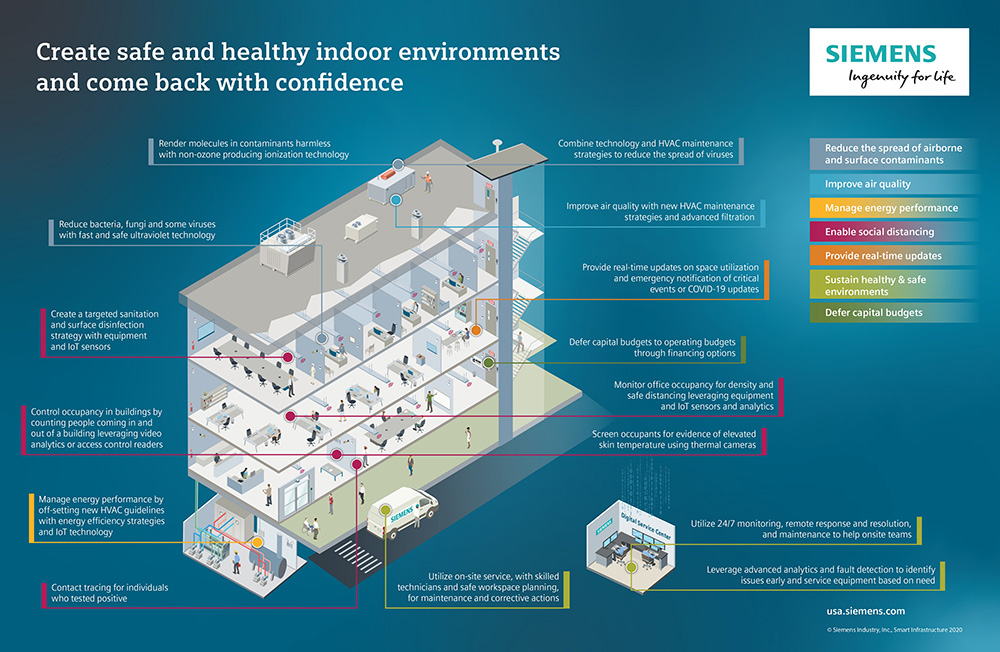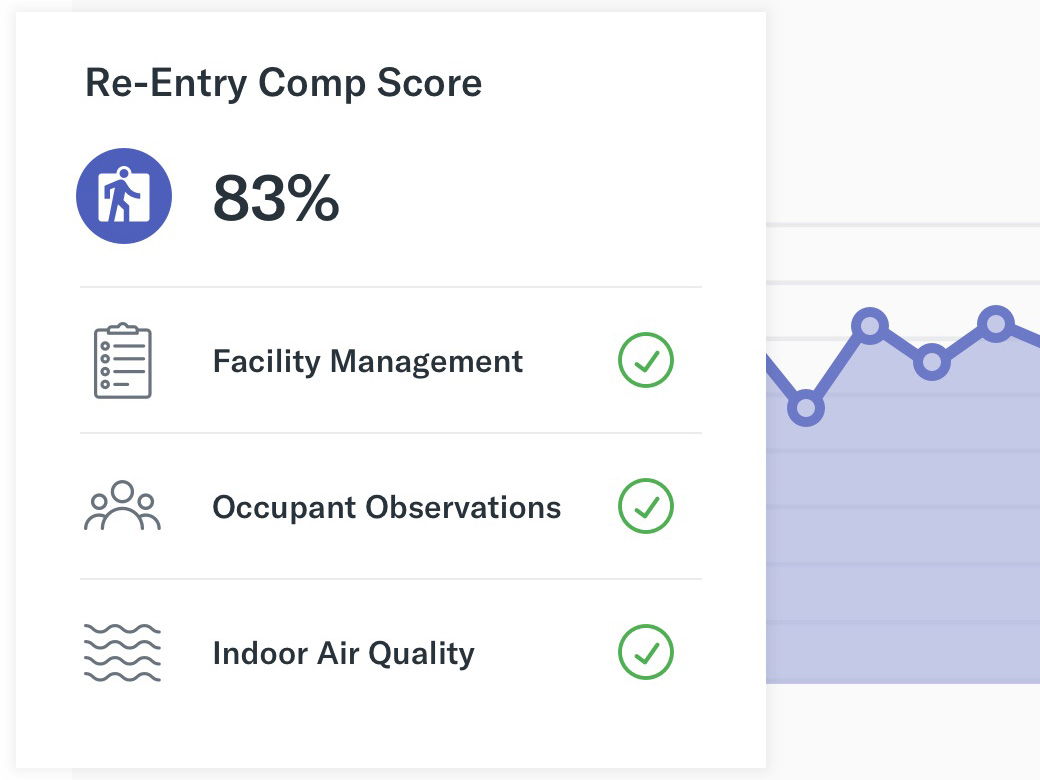Success of the Post-COVID-19 Office Building Hinges on Facilities Decisions
From HVAC systems to elevator buttons, every square inch must be safely addressed before employees return to the workplace.
Thinking about the long-term financial effects of work from home on commercial real estate owners is unsettling. But having employees return gradually to office buildings is actually good news for the operations teams. Fewer people means more space for social distancing and more time for full occupancy—whatever that means for America’s corporations.
READ ALSO: Why Green Leases Will Bloom After the Recession
Organizations like the Centers for Disease Control and Prevention, the Occupational Safety and Health Administration and the American Society of Heating, Refrigerating and Air-Conditioning Engineers have issued new guidelines for building maintenance that are being implemented by property management teams to help keep office workers safe.
“There’s a heightened focus on health and wellness right now due to the pandemic, but property managers, especially those who have been invested in sustainability, have been focused on a lot of this for a long time,” observed Melanie Mayo-Rodgers, director of Facilities for the U.S. Green Building Council.
Rodgers manages the USGBC LEED Platinum headquarters. It’s a learning laboratory and a facility to showcase all that LEED can be—even during a pandemic—right down to the U.S. Environmental Protection Agency-approved cleaning products.
Pick your checklist
USGBC has responded to the pandemic with its stance that healthy people in healthy workplaces leads to a healthy economy, and, as part of that initiative, they’ve introduced new Safety First pilot credits to support LEED projects with their reopening. According to Rodgers, the special pilot credits focus on managing indoor air quality, HVAC systems, building water system reconditioning and testing, cleaning and disinfecting workspaces, and employee reentry to the workplace.
Two of the best places to find return-to-work checklists online, Rodgers adds, are the CDC (Toolkit for Businesses & Workplaces) and OSHA (Guidance on Preparing Workplaces for COVID-19). Resources are also available from Arc Skoru Inc., a technology company affiliated with Green Business Certification Inc. and USGBC. The Arc platform includes the Arc Re-entry Guide and the Arc Improvement Score.
With the slow return to the office, property managers and facility managers are tasked with preparing a space that’s run on low occupancy, where the systems aren’t getting used as much. According to Rodgers, for HVAC, this means a complete building flush, changing filters and confirming filters are installed correctly so that the seal around them limits bypass air that could get by without being filtered.
“You want to increase outdoor air ventilation to increase the air change rate and improve the central air and other HVAC filtration to at least a MERS 13 if possible,” Rodgers explained. “But you have to check to see what’s compatible with your building’s equipment. You want to go for the highest-level filter that’s achievable for your building system. You also want to monitor and maintain relative humidity levels between 40 percent and 60 percent.”
Just as important is flushing all the water lines to prevent Legionella and other biomaterials that can manifest if there has not been regular clean water flushed through. The taps need to be run and water tested to ensure good quality.

From surface sanitation to occupancy tracking, Siemens suggests these steps for creating safe and healthy indoor environments so employees can return with confidence. Image courtesy of Siemens
Minimizing viral spread
Building operators have many questions about increasing their air filter MERV rating, reconfiguring workspaces, performing health checks and new cleaning processes, according to David Santo, segment head for smart mechanical services at Siemens.
“There is no simple, one-size-fits-all answer. There just isn’t,” Santo said.
What is known, however, is that a building’s mechanical systems can play a role in a safer return-to-work strategy and help allay some of the fears many employees may have about emerging from stay-at-home/remote work arrangements. “The goal, of course, is to reduce the health risks to employees and building occupants by reducing the spread of airborne and surface contaminants,” Santo explained.
He notes that emerging research in this area is pretty clear: Viral spread is linked to the presence of fine particles and contaminants in a building. “It does seem that viruses are spreading where those contaminants are more prevalent. As a result, it makes sense to find ways to help minimize viral spread by reducing the number of indoor contaminants.”
Siemens is leveraging the building’s mechanical systems and a range of already available options like ultraviolet light technology and Needlepoint Bipolar Ionization. “Filter MERV rating upgrades and advanced filtration (air scrubbers) are other great ways to treat the air as it flows through your building and ventilation systems,” said Santo.
Key performance indicators can help monitor the quality of the indoor environment. These may include building differential pressure, fine particulate counts, room temperature and room humidity levels as compared to agreed-upon baselines, benchmarks or setpoints.
It is clear that a holistic approach toward infection prevention is essential because there is no single solution today that is 100 percent effective in removing all contaminants.
Exploring cleaning technologies
Right now, many companies are focused on increasing staffing to clean high-touch surfaces like elevator buttons and door pulls. “Those chemicals have to be maintained as wet on the surface for a specific period of time (the “dwell” time is listed on the product labelling) in order for the disinfecting to occur,” according to Marc Fischer, LEED Green Associate, BOMA fellow and president & CEO of InspiRE Commercial Real Estate Services. Fischer is also on the team at Crisis Collaborative, which provides multidisciplinary consultative solutions.
You can apply disinfectants, but you don’t know if the space has been actually disinfected unless you do chemical sampling, adds Fischer. Another downside of traditional cleaning methods is that buttons and door pulls must be cleaned between every use and you must allow the chemical to run for the entire dwell time.
Decision-makers are exploring the benefits of electrostatic sprayer technology (which is not new at all) together with chemical products published on the EPA website that have been shown to be effective on COVID-19. These “Quats” (quaternary ammonium compounds) are potent disinfectant chemicals commonly found in disinfectant wipes, sprays and other household cleaners that are designed to kill germs.
“When you spray in the room, it envelopes all of the materials,” said Fischer, “it goes on all the sides of the desks, the chairs, absolutely every surface in the room and it binds to the surfaces. It lasts for 30 days—unless you scrub it off—without having to reapply.”
Some products and techniques that have been used in medical office buildings and in hospitals are going to be brought to the office sector. Fischer expects we’ll see elevator buttons and door handles made with Microban, a trademarked antimicrobial and built-in active ingredient that enables products to resist the growth of microbes. And while offices might not see the UV light robots that sanitize an operating room in between procedures during this pandemic, there’s a spectrum of UV light called Far UVC in development that could be installed in the ceiling to provide sanitization throughout the day.

Arc Skoru Inc. has released a tool to help maintenance teams score their preparedness for office-building reentry efforts. Image courtesy of Arc Skoru Inc.
Learning from global partners
JLL has put together engineering protocols on how to properly operate the office building and has distributed these protocols to all of the JLL national property teams. “Essentially, these include increasing outside fresh air, meeting or exceeding CDC and ASHRAE standards, recommissioning of building mechanical systems and following our water management plans,” said William Schuch, JLL national engineering manager of property management. “In addition, increased communications with tenants are key as we mitigate any potential risks of spreading airborne pathogens.”
Reentry plans for tenant occupiers were developed and are customized specific to each building based on space type, square footage, occupancy, tenant needs and the type of building systems. JLL has created a reentry workbook for property managers and engineering staff that will guide them in such areas as education, engineering procedures, experience management, health screening, janitorial practices and more.
“Due to JLL’s global footprint, we were able to learn best practices from our global partners in Asia and Europe that handled the pandemic prior to our teams in the U.S.,” Schuch added. “Some of the very first measures we put in place came from our counterparts in China. Specifically, understanding how the peak demand of visitors can be addressed in advance of reentry.”
Don’t phone it in
Even before the pandemic, Carbon Lighthouse was using its AI based software platform for clients like Madison International Realty and the Moinian Group to drive deep data analytics into HVAC and lighting systems to uncover efficiency reserves. REITs and real estate investors that work with Carbon Lighthouse have been realizing increases in their building value at pretty much any stage in the asset life cycle by about $5 to $10 a square foot, according to Matt Ganser, executive vice president for Engineering and Technology at Carbon Lighthouse.
“Now we’re advocating that buildings apply a smarter approach to mitigating COVID-19 versus throwing the kitchen sink at it,” said Ganser. “We think a lot of the measures that ASHRAE and CDC are putting out are very rational and they make sense, but they are fairly conservative and put the building at risk [financially] by spending money unnecessarily. The default is to try to follow ASHRAE and CDC. The smart play is to try to separate out how to deliver that same level of safety without the risk of rent inflating.”
Perhaps a silver lining emerging from the current crisis is the deeper appreciation for the importance of indoor air quality. “There has never been this much attention around ventilation probably since Willis Carrier and his invention of modern HVAC systems at the beginning of the 20th century—and you see this not only from our clients but also from their tenants,” said Ganser.
“We know from our clients that their tenants are Googling HVAC guidelines and ASHRAE guidelines and CDC guidelines and coming to them and asking, ‘Can you tell me what you guys are doing to provide a safe space?’ If you respond to that well—and you don’t phone it in—this can be a driver of retaining your tenants or potentially securing new leases in the future, so it doesn’t have to be just a risk mitigation strategy it can be a strategy to maintain or even increase your revenue.”







You must be logged in to post a comment.